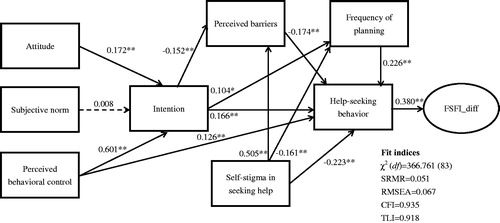Figures & data
Figure 1. Using extended theory of planned behavior to explain the help-seeking behavior in sexual problem and the sexual function. FSFI_diff: FSFI follow-up latent score minus FSFI baseline latent score; FSFI: female sexual function index; SRMR: standardized root mean square residual; RMSEA: root mean square error of approximation; CFI: comparative fit index; TLI: Tucker-Lewis index. Age, NYHA, and BMI were controlled in the model. Dashed lines indicate nonsignificant relationship; solid lines indicate significant relationship. *p < .05; **p < .01

Table 1. Participant characteristics (N = 758).
Table 2. Mediated effects of frequency of planning, perceived barriers, and help-seek behavior.
